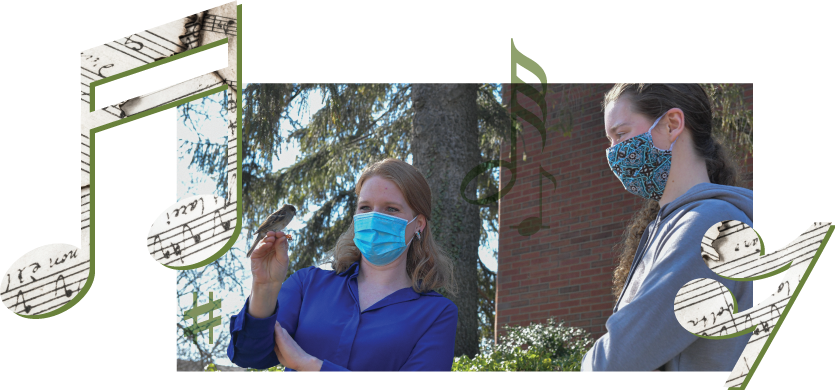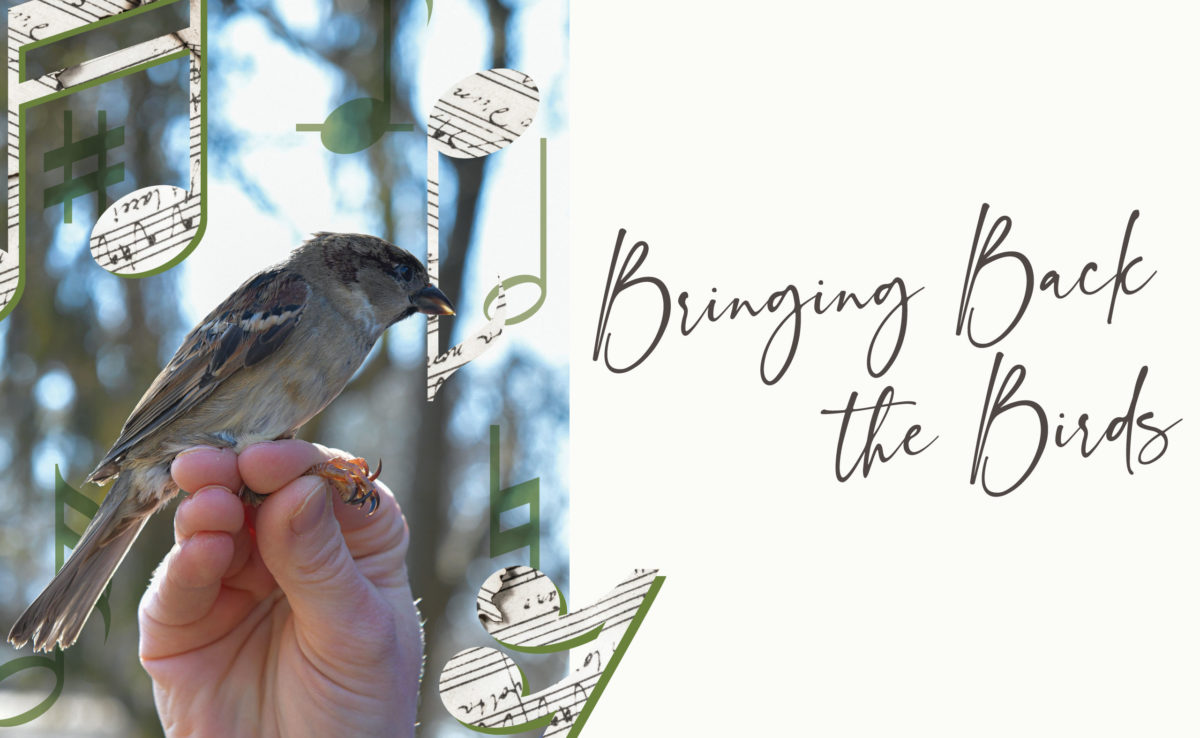Bringing Back the Birds
Each year, we in more northern climes appreciate when various bird species return to our regions on the fresh wisps of spring. In fact, we eagerly anticipate their arrival with high seasonal acuity. After our muted long-winter life, “Hey, I saw my first robin today!” is as much a rite of spring as spotting college students wearing shorts in March.
Yet, while we revel in seeing and hearing renewed bird chirps and antics, what if they actually can’t hear or see each other? What if the things we humans take for granted (birdsong, bird flight) are things that the birds themselves are having problems identifying?
What if the birds are the ones with a failure to communicate?
Self-professed bird nerd Dr. Kelly Ronald, assistant professor of biology, has spent the past year hoping to answer those questions from a bird’s eye, and ear, point of view. Her collaborative faculty-student research team, which includes eight student-researchers, is studying how increased noise and light due to human activity affect birds’ ability to hear and see in both urban and rural settings. House sparrows are serving as their subjects to help them, and eventually other scientists, begin to understand more broadly why the number of birds in North America has been declining. A recent study, published in Science magazine in October 2019, reports that the total bird population has fallen by 29 percent since 1970.
That’s an estimated loss of nearly three billion birds.
“Birds combine lots of sensory modalities to make behavioral decisions from mate choice, to caring for offspring, to predator-prey decisions,” Ronald explains. “But changes in the physical environment caused by human activity alter environmental sound and light profiles, so birds’ behaviors have to change, too.”
For example, Ronald notes that previous research has shown that birds in urban areas sing at higher frequencies or louder amplitudes to avoid the masking caused by lower-frequency traffic noise. “But currently, very few people are asking questions on the sensory reception side,” she says. “So, we know these animals are changing signal production due to urbanization, but what is happening, if anything, on the signal reception side? Ultimately, as communication involves the successful reception of signals, it is imperative that we examine receiver sensory processing as well.”
So, that means that Ronald and her students have to give birds sight and hearing tests. But first, they have to have birds to which the tests can be given.
“Birds combine lots of sensory modalities to make behavioral decisions from mate choice, to caring for offspring, to predator-prey decisions. But changes in the physical environment caused by human activity alter environmental sound and light profiles, so birds’ behaviors have to change, too.”
So, step one: Find some birds.
Student-researcher Sarah Yonker, a senior biology major, vividly recalls a morning when she and Ronald traveled to a horse stable in Nunica, about 30 minutes away from campus, to attempt to capture rural house sparrows. In the quiet of a frigid early morning in January, Yonker and Ronald worked together to set up mist nets without gloves on “because the nets are so fine, you need to put them out with your bare hands,” recalls Yonker, who will enter veterinary school in the fall at Michigan State University. “Our fingers felt frozen, but it actually was a fun experience. There was a beautiful sunrise that day, and we got our first female house sparrow for the lab.”
Ronald uses house sparrows because of their abundance — in fact, they are an invasive, non-native, pest-like species to North America — and hopes to have a mix of 60 country and city birds. She works in conjunction with Holland’s DeGraaf Nature Center and nearby Outdoor Discovery Center to gather birds and also enlists the help of friends with feeders. Her lab protocol houses the birds for a number of weeks while providing them with natural perches, as well as bird toys, and feeding them a steady diet of seeds, mealworms, millet sprays, vitamin water and grit. Since house sparrows are fairly social, they are always paired with same-sex co-habitants; Ronald doesn’t really need to welcome any baby sparrows to her laboratory brood, after all. The animal care staff at Hope also checks on them daily.
“We plan to use this project to obtain some baseline information [from sparrows] and jump from that to studying native species as well,” Yonker says.
Onto step two: Administer a hearing test to the birds.
This sounds dicey, doesn’t it? How do you even begin to determine if a wild bird is hearing and seeing what you want it to hear and see? It turns out that the methodology for that is more common than you might think.
“We do what are called auditory-evoked potentials and visual-evoked potentials, and people are pretty familiar with the auditory-evoked potentials,” Ronald says. “This is what newborn humans are given for their newborn hearing screening tests. You put electrodes right at the surface of the skin. Then you play a sound and make sure that the auditory nerve is responding to that sound as you would expect. We do that same sort of thing with the birds. I sedate them, and then I play them different frequencies of sound at different intensities or amplitudes to assess how they hear. It’s a very similar type of process with vision, except instead of presenting sounds, I’m presenting lights to them to see how the retina is responding.”
Through a grant she received from the Christian Scholars Foundation, Ronald purchased the auditory and visual assessment equipment from a company that sells the very same apparatus to hospitals. “I actually had to sign a waiver saying I wasn’t going to assess any humans for diagnostic reasons with this equipment,” she says. She assured them that, of course, it was just for the birds. (Oh, c’mon, you had to know that cliché was coming.)
Step three: Process that data.
This phase has yet to begin for the members of Ronald research team. They are still busy finding birds and conducting sensory tests. But Ronald has some theories that may seem indubitable – like too much exposure to constant, loud noise (think jackhammer operators without ear plugs) causes worse bird hearing – and some that aren’t.
“Birds are interesting because they can regenerate their hair cells (sensory receptors in the ears of all vertebrates) while mammals cannot,” Ronald explains. “So noise may not have as strong of an effect on the birds as it would for a mammal, but we just don’t know. I’m thinking that perhaps they have elevated thresholds. Like, we’re not going to see as much of a response until we turn the volume of the sound up.”
In terms of bird vision, not as much is known, Ronald adds. “There is some evidence in humans that nighttime glare can affect how we perceive patterns. I’m just expecting that there might be a difference between animals that are exposed to a lot of nighttime glare, rather than birds [who don’t experience] as much.”

Finally, in every step: Mentor and teach Hope students.
Ronald arrived at Hope in the summer of 2019 as sensory physiology/ecologist eager to engage Hope students in her lab immediately because she believes that research is where “real science can actually happen,” she says. “It’s where I can teach my students that science is hard and doesn’t work all the time. . . So, resiliency and problem-solving are as much a part of our work as the science itself.”
Yonker says she has learned those lessons and more in her work with Ronald. Though she plans to become an equine vet, working with these delicate animals has given her an appreciation for the research methods that field biologists use, such as “bird identification, banding, and mist netting,” says Yonker, who earned a national research scholarship through the Garden Club of America to conduct the project with Ronald.
“I also strengthened my public presentation and writing skills, specifically scientific writing, working on a manuscript for publication. I personally enjoyed having an energetic and enthusiastic mentor who encouraged me to step out of my comfort zone and develop additional research interests.”
Eventually, professor and student hope their work will influence future conservation efforts for bird species who make their homes where anthropogenic (human-caused) light and sound abound. To live in harmony with harmonic birds, pressing questions, like, “How do we design cities and structures to be friendlier to cohabitating animals,” require urgent answers.
“Birds are beautiful and fun to look at, of course, but they also pollinate plants, they disperse seeds,” Ronald emphasizes, an avian affinity obvious in her tone. “They just do so many great things that make our world better.”
What if, while we revel in seeing and hearing bird chirps and antics, they actually can’t hear or see each other?
What if the things we humans take for granted (birdsong, bird flight) are things that the birds themselves are having problems identifying?

